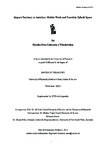Airport Territory as Interface: Mobile Work and Travel in Hybrid Space.
| dc.contributor.supervisor | Scott, Jillian, Dr. | |
| dc.contributor.author | Codourey, Monika Ewa | |
| dc.contributor.other | Faculty of Arts, Humanities and Business | en_US |
| dc.date.accessioned | 2017-05-24T10:37:51Z | |
| dc.date.available | 2017-05-24T10:37:51Z | |
| dc.date.issued | 2015 | |
| dc.identifier | 10092075 | en_US |
| dc.identifier.uri | http://hdl.handle.net/10026.1/9331 | |
| dc.description.abstract |
Premise In order to understand the future potential of work and air travel experience for constant travellers, design approaches from architecture and research methods from social studies should be combined. Abstract Global mobility, wireless technology and networked society are transforming the airport territory. These changes (hard factors) have been analysed in airport planning and transportation studies (Koll-Schretzenmayr 2003; Banister 2003; Schaafsma 2003; Knippenberger &Wall 2010; Salewski & Michaelli 2011; Convenz & Thierstein ed. 2014 et al) and architecture and design (Edwards 1998; Blow 2005; Cuadra 2002; Uffelen 2012; Gensler 2013 et al). But design strategies focusing on the passenger experience (soft factors) have not yet been thoroughly assimilated by architecture and design. On the theoretical level this dissertation spans the analysis of current methodologies in social studies (e.g. Castells 1996; Gottdiener 2000; Cresswell 2006; Urry, 2007; Elliott & Urry 2010; Adey 2010 et al) and their relation to architectural and urban studies concepts for the airport. The latter includes the “Airport as City” (Güller & Güller 2000), “Aviopolis – A Book about Airports” (Fuller & Harley 2005) and “Aerotropolis” (Kassarda 2010). This dissertation also explores IT and aviation industry interests at the interface between technology and air travellers. In this light aviation industry research and solutions (Amadeus 2011, SITA 2013) are important to consider, as well the philosophy behind who travels and for what purpose (Sloterdijk 1998; Koolhaas 1998; Gottdiener 2000; Urry 2007; Birtchnell & Caletrio 2014 et al). Here, the author’s previous field research at Frankfurt International Airport is relevant. We live more mobile lifestyles, we work in hybrid spaces (Suoza 2006; Duffy 2010 et al), and we consequently need to share information and collaborate differently. Using constant travellers as a case study, the impact of physical and informational mobility on perceptions of and behavioural patterns in the airport can lead to a deeper understanding of mobile work and the air travel experience. New design strategies can be developed from research about constant travellers, and the results may improve their work and air travel experience. The author’s combination of design approaches from architecture and social science (sociology and psychology) methodologies can better address the real needs of constant travellers in hybrid workspaces. It is hoped that this dissertation will inspire airport architects and designers, interaction designers and the aviation industry to pay more attention to users’ needs in their design processes. | en_US |
| dc.language.iso | en | en_US |
| dc.publisher | Plymouth University | en_US |
| dc.subject | Airport Design | en_US |
| dc.subject | constant travellers | |
| dc.subject | Knowledge Workers | |
| dc.subject | Passenger Experience | |
| dc.subject | Mobile Work | |
| dc.subject | Air Travel | |
| dc.subject | Hybrid Space | |
| dc.subject | Workplace Design | |
| dc.subject | Mobile and Locative Media | |
| dc.subject | Geo-locational Games | |
| dc.subject | Design Strategies | |
| dc.subject | Holistic approach to design | |
| dc.title | Airport Territory as Interface: Mobile Work and Travel in Hybrid Space. | en_US |
| dc.type | Thesis | |
| plymouth.version | Edited version | en_US |
| dc.identifier.doi | http://dx.doi.org/10.24382/3584 |
Files in this item
This item appears in the following Collection(s)
-
01 Research Theses Main Collection
Research Theses Main


